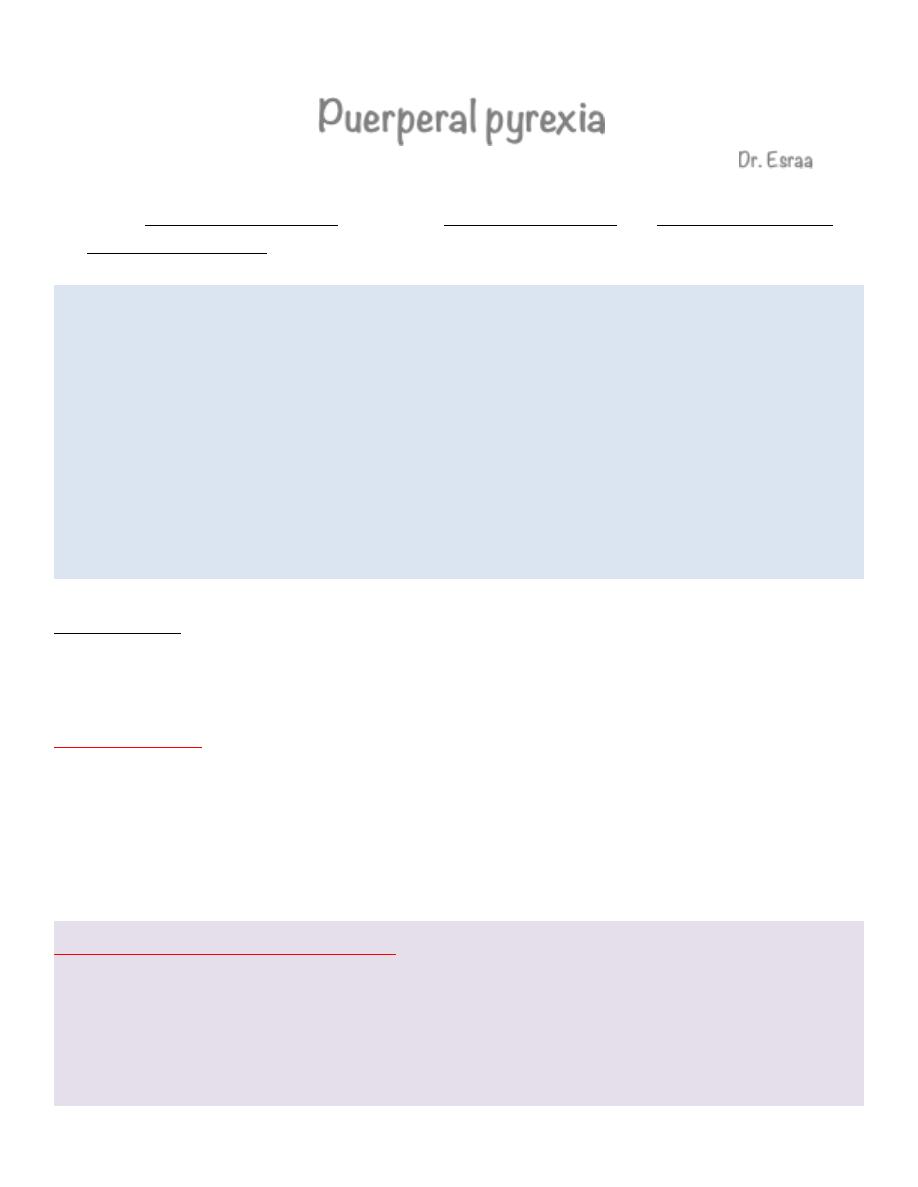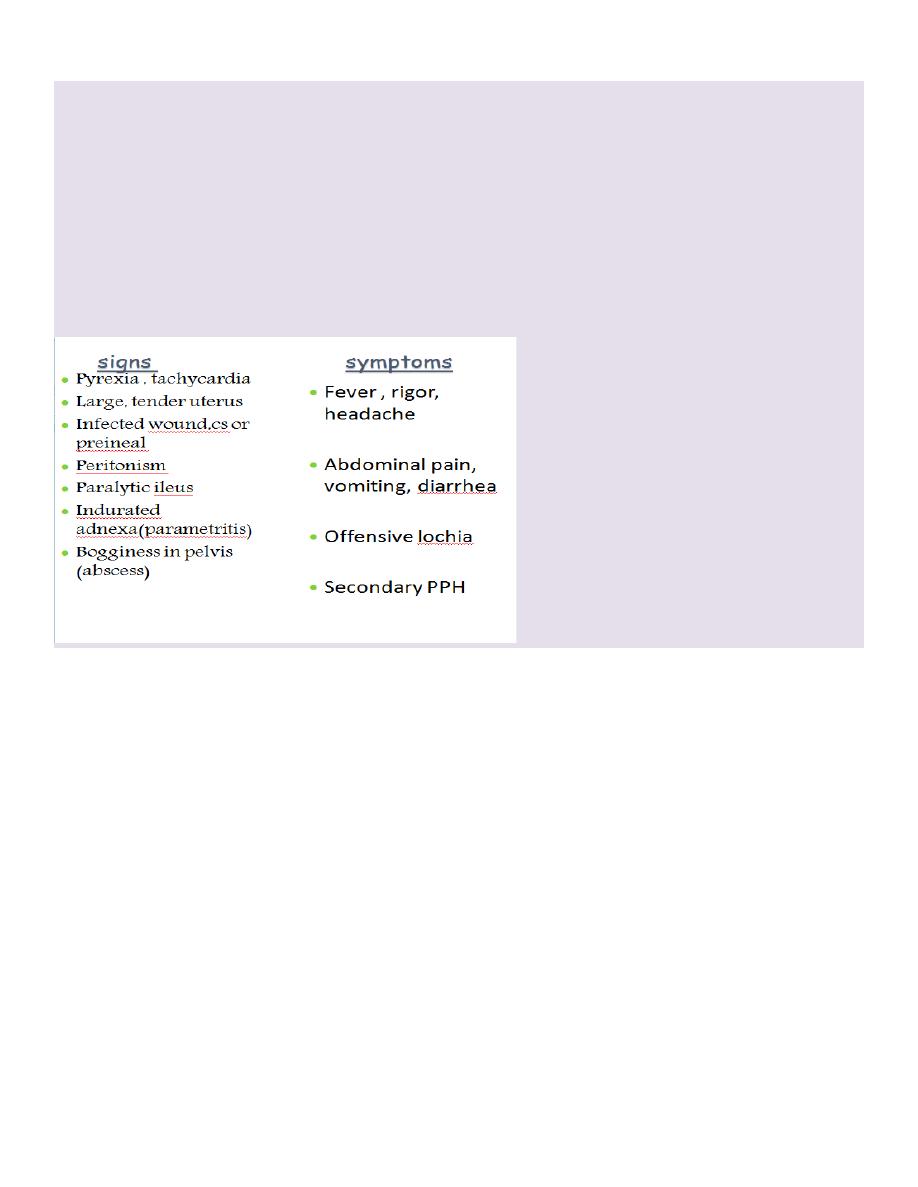
!1
Puerperal pyrexia
Dr. Esraa
Pueperal pyrexia
Is defined as temperature 38 C or higher that occurs for more than 2 consecutive days, exclusive of 1
st
postpartum
day, during first 10 postpartum days.
causes of p. pyrexia
1. Endometritis
2.Chest infection, Pneumonia
3.Tonsillitis
4.Meningitis
5.Pyelonephritis
6.Mastitis & abscess
7.DVT
8.Pulmonary embolism
9.Retained placenta
Chest complication
Appear in 1
st
24 hr after delivery, especially after GA .
Ataelectasis is associated with fever, can be prevented by regular chest physiotherapy.
Aspiration pneumonia (mendleson s syndrome) is associated with wheezy chest, dyspnoea, spiking temp.
Urinary tract infection
This is common infection during puerperium due to frequent catheterization of bladder during labour, sometimes may be
there is urinary retention . E.coli is most commonest pathogen & early treatment is advised.
Predisposing factors(risk factors):
1. Poor hygiene and nutrition
2. Anaemia
3. Premature rupture of membrane
4. Prolonged rupture of membrane
5. Prolonged labour

!2
6. Frequent vaginal examination during labour
7. Antenatal intrauterine infection.
8. Cervical cerclage for cx insufficiency
9. Caesarean delivery
10. Forceps or vacuum delivery
11. Cervical or vaginal laceration
12. Manual removal of placenta
13. Retained placental fragment or fetal membrane.
14.Non obstetrical (DM, Obesity)
investigation
FBC: anaemia, leukocytosis, TCP
U&E: fluid &electrolyte imbalance
HVS: infection screen &bl. Culture
Pelvic US: retained product and pl.abscess
Clotting screen : DIC
Arterial blood gas:acidosis&hypoxia
Methods of spread of puerperal infection
1. Ascending infection from lower genital tract or primary infection of placental site may spread via fallopian tubes to
ovaries leading to salpigo-oohoritis & pelvic peritonitis which can progress to generalized peritonitis &pelvic abcess.
2. Direct spread of infection to myometrium & parametrium leading to metritis& parametritis. Pelvic peritonitis
&abscess may also occur.
3. Spread via lymphatic & blood vessels, infection from uterus by uterine vessel to IVC via iliac vessels or directly via
ovarian vessels this can lead to septic thrombophlebitis , generalized septicaemia & endotoxic shock

!3
Treatment
Co amoxiclave or Cephalosporins + metranidazole ----for mild & moderate cases.
Depending on severity1
st
few doses should be given intravenously.
with severe infection release of inflammatory mediators in response to endotoxin produced during bacteriolysis leading
local vasodilataion & poor tissue perfusion. This is known as septic shock or endotoxic shock &any delay in Mx could
be fatal
Prevention of puerperal sepsis
1. Increase awareness of general health
2.Good surgical techniques
3.Use of aseptic measure, risk of sepsis is higher after CS especially when performed after onset of labour.
4.Prophylactic AB during emergency CS reduce the risk of post op infection.
5.A single intra-operative dose amoxiclave or cephalosporine + metronidazole given after clamping of cord to avoid
unnecessary exposure of baby to AB, while in elective CS prophylactic AB is given when infectious morbidity is high
